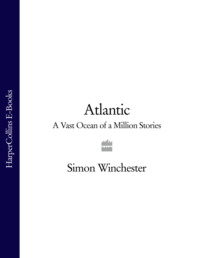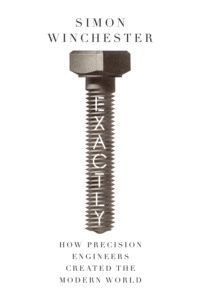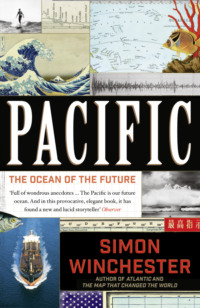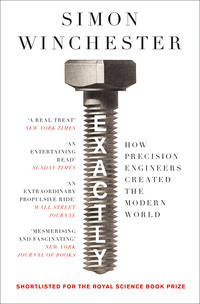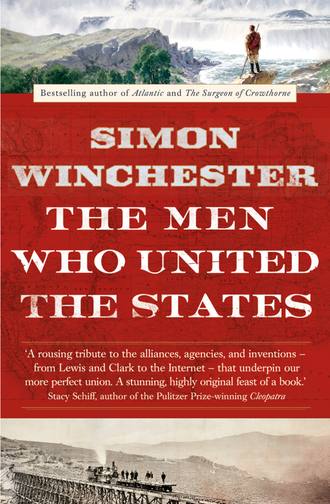
Полная версия
The Men Who United the States: The Amazing Stories of the Explorers, Inventors and Mavericks Who Made America

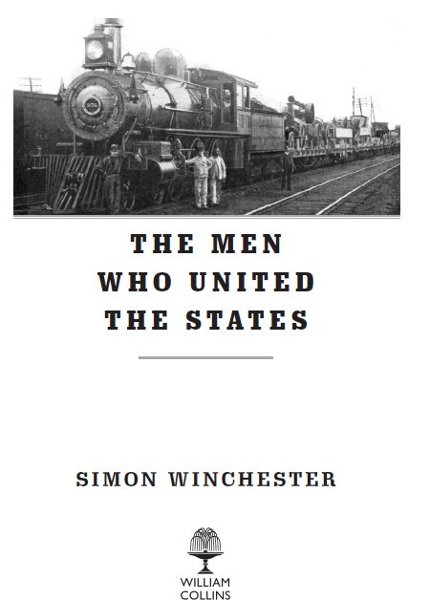
Copyright
William Collins
An imprint of HarperCollinsPublishers 77–85 Fulham Palace Road, Hammersmith, London W6 8JB
www.harpercollins.co.uk
First published in Great Britain by William Collins in 2013
Copyright © Simon Winchester 2013
Simon Winchester asserts the moral right to be identified as the author of this work.
A catalogue record for this book is available from the British Library.
Original jacket design by Richard Ljoenes. Map courtesy of the Library of Congress. Front cover: (top) The Arrival of Captain Lewis at the Great Falls of Missouri, courtesy of the artist, Charles Fritz; (bottom) Trestle at Promontory, by Andrew J. Russell, from photographs taken during construction of the Union Pacific Railroad, Beinecke Rare Book and Manuscript Library, Yale University.
All rights reserved under International and Pan-American Copyright Conventions. By payment of the required fees, you have been granted the non-exclusive, non-transferable right to access and read the text of this e-book on-screen. No part of this text may be reproduced, transmitted, down-loaded, decompiled, reverse engineered, or stored in or introduced into any information storage and retrieval system, in any form or by any means, whether electronic or mechanical, now known or hereinafter invented, without the express written permission of HarperCollins
Source HB ISBN: 9780007532377
Ebook Edition © September 2013 ISBN: 9780007532384
Version: 2014-06-26
Praise
From the reviews of The Men Who United the States:
‘Simon Winchester is one of the quintessentially English writers who will go anywhere, literally and figuratively … because of his amateur status, boldness and decidedly nonacademic approach to history, [he] achieves something remarkable here’
Literary Review
‘Winchester understands that specificity is what counts, as it always does in writing … He has read prodigiously, and has pounded the trail with equal diligence’
Sunday Telegraph
‘This book’s cleverness lies in an organization neither chronological nor biographical, but elemental: there are five sections on wood, earth, fire, water and metal … This is an imaginative piece of historical writing, interwoven with memoir. But it is, in the end, more than either of those things: it is a love poem to the American landscape and to the spirit of people, now dead, who traversed it’
BBC History
‘Entertaining … A pleasure’
New York Times Book Review
‘Mesmerizing and fascinating … Winchester is a master storyteller, and all the individuals, places, and events that he passionately writes about come to life in exquisite detail … a magnificent achievement in writing, storytelling, and education’
New York Journal of Books
‘The fun here is in Winchester’s exuberant enthusiasm for his new country and for the characters he has found who helped shape it’
Washington Post
‘Vivid, valuable … Winchester’s book is especially fine on retrieving the forgotten map makers, geologists, topographers and engineers who showed them the way … what an extraordinary, propulsive tale he tells’
Wall Street Journal
‘Simon Winchester never disappoints, and The Men Who United the States is a lively and surprising account of how this sprawling piece of geography became a nation. This is America from the ground up. Inspiring and engaging’
Tom Brokaw
‘A very charming and meticulously researched celebration of America’s enduring unity and the various people and historical forces that have made it possible’
The National
‘An elegantly written account … filled with fascinating information’
Boston Globe
‘Another winning book from a historian whose passion for his subjects saturates his works’
Kirkus Reviews
‘Winchester masterfully evokes the excitement of the nation’s early days – when opportunity and possibility were manifest in uncharted mountains and new technologies – while bringing each of his subjects to life … the key to the book’s greatest achievement [is in] conveying the large-scale narrative of unification via the small-scale experience of the individual – the creation of a people by the agglomeration of persons’
Publisher’s Weekly
‘[His] writing style is a fortuitous juxtaposition of the rigors of scientific inquiry with the reporter’s keen eye for a good story. The happy result is this elegantly written and captivating meditation on the unique physiology of that cultural-political phenomenon known as the United States of America’
Washington Times
Dedication
February 23, 2012, was the eightieth birthday of my mother-in-law,
MRS. AKIKO SATO.
Shortly before the family celebration, I told her of my plan to structure my book around the five so-called classical elements. She briefly left the room, returning with this card on which she had handwritten this aide-mémoire for me, the five elements rendered in English, Chinese characters, and Japanese.
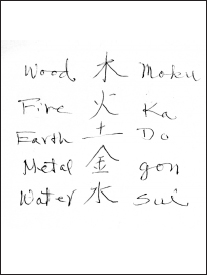
Three hours later, toward the end of her party, happy and surrounded by friends and family, Mrs. Sato collapsed and later died.
This card was thus the very last thing she ever wrote in her life—one ample reason among many for me to offer this book as dedication both to her daughter
SETSUKO
and, with gratitude and respect, to the memory of
MRS. AKIKO SATO.
Born, Tokyo, 1932. Died, New York, 2012.
May this small offering be her memorial.
Epigraph
Think of the United States today—the facts of these thirty-eight or forty empires solder’d in one—sixty or seventy millions of equals, with their lives, their passions, their future—these incalculable, modern, American, seething multitudes around us, of which we are inseparable parts!
—WALT WHITMAN, A Backward Glance o’er Travell’d Roads (PREFACE TO THE 1888 EDITION OF Leaves of Grass)
CONTENTS
Cover
Title Page
Copyright
Praise
Dedication
Epigraph
List of Maps and Illustrations
Author’s Note
Preface: The Pure Physics of Union
PART I: WHEN AMERICA’S STORY WAS DOMINATED BY WOOD, 1785–1805
A View across the Ridge
Drawing a Line in the Sand
Peering through the Trees
The Frontier and the Thesis
The Wood Was Become Grass
Encounters with the Sioux
First Lady of the Plains
High Plains Rafters
Passing the Gateway
Shoreline Passage
PART II: WHEN AMERICA’S STORY WENT BENEATH THE EARTH, 1809–1901
The Lasting Benefit of Harmony
The Science That Changed America
Drawing the Colors of Rocks
The Wellspring of Knowledge
The Tapestry of Underneath
Setting the Lures
Off to See the Elephant
The West, Revealed
The Singular First Adventure of Kapurats
The Men Who Gave Us Yellowstone
Diamonds, Sex, and Race
PART III: WHEN THE AMERICAN STORY TRAVELED BY WATER, 1803–1900
Journeys to the Fall Line
The Streams beyond the Hills
The Pivot and the Feather
The First Big Dig
The Wedded Waters of New York
The Linkman Cometh
That Ol’ Man River
PART IV: WHEN THE AMERICAN STORY WAS FANNED BY FIRE, 1811–1956
May the Roads Rise Up
Rain, Steam, and Speed
The Annihilation of the In-Between
The Immortal Legacy of Crazy Judah
Colonel Eisenhower’s Epiphanic Expedition
The Colossus of Roads
And Then We Looked Up
The Twelve-Week Crossing
PART V: WHEN THE AMERICAN STORY WAS TOLD THROUGH METAL, 1835–TOMORROW
To Go, but Not to Move
The Man Who Tamed the Lightning
The Signal Power of Human Speech
With Power for One and All
Lighting the Corn, Powering the Prairie
The Talk of the Nation
Making Money from Air
Television: The Irresistible Force
The All of Some Knowledge
EPILOGUE
Footnotes
Bibliography
Searchable Terms
Acknowledgments
About the Author
Also by Simon Winchester
About the Publisher
MAPS AND ILLUSTRATIONS
Illustrations noted as “(pd.)” are in the public domain.
1. The five classical elements. (Lettering by Mrs. Akiko Sato; courtesy of the author)
2. The Point of Beginning, East Liverpool, Ohio. (Courtesy of the author)
3. The B-2 bomber squadron at Whiteman Air Force Base. (Courtesy of the US Department of Defense, photograph by SrA Jessica Kachman, June 1998)
4. William Maclure in New Harmony. (Painting by Thomas Sully, courtesy of the Academy of Natural Sciences, Ewell Sale Stewart Library, Drexel University)
5. Maclure’s geological map of the United States. (Courtesy of David Rumsey Map Collection, www.davidrumsey.com)
6. Gouverneur Warren’s 1858 map. (Courtesy of Derek Hayes)
7. John Wesley Powell. (Courtesy of the Library of Congress)
8. Steamboat Rock. (Courtesy of the author)
9. The Grand Canyon of the Yellowstone (Painting by Thomas Moran, 1893; courtesy of the Smithsonian American Art Museum, Washington, DC/Art Resource, NY)
10. Clarence King in the field. (Courtesy of the US Geological Survey Photographic Library)
11. Ada Copeland (also known as Mrs. King or Mrs. Todd) with her son Wallace. (Courtesy of the New York Daily News)
12. The Youghiogheny River. (Courtesy of the author)
13. A column by “Hercules” in the Genesee Messenger. (Courtesy of The New-York Historical Society)
14. “Wedding of the Waters” ceremony, New York. (Copyright 1905, C. Y. Turner)
15. Asian carp. (Courtesy of Nerissa Michaels)
16. The Chancellor Livingston. (Courtesy of The New-York Historical Society)
17. Donner Pass. (pd.)
18. On the 1919 motor convoy. (Courtesy of the National Archives)
19. The “Good Roads Train.” (Courtesy of Project Gutenberg)
20. Thomas MacDonald. (Courtesy of the Library of Congress)
21. “Good Roads Everywhere” map. (Courtesy of Derek Hayes)
22. Map of the Interstate Highway System. (Courtesy of Derek Hayes)
23. Opening of the I-94, in Wisconsin. (Courtesy of the Wisconsin Historical Society)
24. Cal Rodgers. (Courtesy of Stephen White)
25. Cal Rodgers’s plane. (Courtesy of Stephen White)
26. Farny’s The Song of the Talking Wire. (Courtesy of the Taft Museum of Art, Cincinnati)
27. Samuel Morse’s patent, No. 1,647. (Courtesy of the US Patent Office)
28. Samuel Morse sending the first telegraph message. (© Bettmann/CORBIS)
29. Telephone wires in New York City. (Courtesy of Stephen White)
30. Electricity demonstration. (Courtesy of Stephen White)
31. Nikola Tesla. (pd.)
32. “PWA Rebuilds the Nation” poster. (Courtesy of David Rumsey Map Collection, www.davidrumsey.com)
33. Reginald Fessenden and his transmitter lab. (pd.)
34. Family grouped around a radio receiver. (Courtesy of Stephen White)
35. Johnny Carson. (pd.)
36. Joseph Licklider. (pd.)
37. Vint Cerf. (Courtesy of Joi Ito, 2007)
38. Robert Kahn. (pd.)
39. Google server farm. (Photograph by Connie Zhou; courtesy of Google)
AUTHOR’S NOTE
On Independence Day, July 4, 2011, I swore a solemn oath before a federal judge on the afterdeck of the warship USS Constitution in Boston Harbor, and by doing so I became, after half a century of dreaming, a naturalized American citizen. The following day I acquired my voter’s registration card; a week later I was issued my first American passport, a document on which I have traveled ever since. When I returned to Kennedy Airport after my first trip overseas as an American, I was little prepared for my reaction when the immigration officer remarked with casual warmth, “Welcome home.” I felt almost overwhelmed by at last now being a part of all of this.
The most recent design of an American passport incorporates a series of declarative epigraphs at the top of each visa page. Samuel Adams: “What a glorious morning for our country.” The inscription on the Golden Spike at Promontory Summit in Utah: “May God continue the unity of our country as the railroad unites the two great oceans of the world.” And Jessamyn West’s description of the railway as “A big iron needle stitching the country together.”
But of all the quotations, the one I like most is a paragraph taken from Lyndon Johnson’s inaugural address of January 20, 1965. The nation was at the time still shocked by the tragic shooting of President Kennedy—the event that elevated LBJ to the presidency. The country, still mired in Vietnam, was in a liverish mood, and many more tragedies were yet to come. But Johnson, seeking by his speech to help salve the country’s wounds and to better the temper of the times, spoke in an optimistic vein:
For this is what America is all about. It is the uncrossed desert and the unclimbed ridge. It is the star that is not reached and the harvest sleeping in the unplowed ground. Is our world gone? We say “Farewell.” Is a new world coming? We welcome it—and we will bend it to the hopes of man.
The pages that follow are devoted in large part to those men who, in the overarching interests of welding the nation together, traversed those uncrossed deserts and scaled those unclimbed ridges, offering in their own times and their own ways the promise of a better place and of better times ahead.
PREFACE: THE PURE PHYSICS of UNION
E pluribus unum.
—SINCE 1782, THE MOTTO ON THE OFFICIAL SEAL OF THE UNITED STATES
Early in the crisp small hours of November 7, 2012, a weary but exultant Barack Obama was thanking his countrymen for just handing him a second term as forty-fourth president of the United States. His speech was brief, but it rang with an eloquence that moved well beyond the platitudes of the pitiless election season that had mercifully ended in this culmination just moments before.
It was a speech that spelled out President Obama’s unyieldingly optimistic belief in the future of a country that had allowed him, a young black man, to be invested, now for a second term, as the most powerful human being on the planet. He had been given this role, he said, with a new chance to perfect still further the immense entity that is the American union, more than two centuries after his country had declared its independence from colonial rule.
Such was the crowd’s exuberance that much of what the president said was drowned in a cacophony of cheering and frenzied delight. Sensing the mood, he prudently kept what he had to say brief and to the point. After no more than ten minutes of high rhetoric, the tone of his voice fell and quieted—he was coming to the end.
“I believe we can seize this future together,” he said, “because we are not as divided as our politics suggests. We’re not as cynical as the pundits believe. We are greater than the sum of our individual ambitions, and we remain more than a collection of red states and blue states. We are and forever will be”—and here he paused for just a beat, to add solemn emphasis to the adjective—“the United States of America.”
The United States. This unique national quality—of first becoming and then remaining so decidedly united—is a creation that, in spite of episodes of trial and war and suffering and stress, has been sustained for almost two and half centuries across the great magical confusion that is the American nation. The account that follows, then, is on one level a meditation on the nature of this American unity, a hymn to the creation of oneness, a parsing of the rich complexities that lie behind the country’s so-simple-sounding motto: E pluribus unum.
America is, after all, a nation founded as a home for the single simple ideal of universal human freedom. The country was established as a grand experiment, with people invited from all over the world to take part, to help build a nation of free souls, each to be given an equal opportunity to seek as each saw best the greatest happiness for themselves. The question I try to address in the following chapters is: just how has it managed to adhere, to keep itself annealed into one for all the years and decades since?
Unity among peoples, in a country as complicated as America, is just not an organic thing. In countries with less convoluted pedigrees it might well be. By way of analogy, people in tribes tend toward natural unity—whether they are Kikuyu, Comanche, Wurundjeri, or Micmac, individuals within each tribe bond together tightly. Clans in Scotland are proud of being firm-welded entities of great antiquity—all McKenzies and MacNeils are one, Scots like to say, whether fortune or happenstance has led them to be dukes or dustmen. Elsewhere class and the tendency toward an intellectual aristocracy have magnified a sense of union—Etonians, graduates of Hotchkiss and Science Po, Harvard and Christ Church may all bond clubbably, as may most European marquesses and counts or their American equivalents, the Biddles, Lowells, Cabots, and Saltonstalls. Race likewise has an annealing affect: Harlem and Hough and Watts and a score of other places have long offered local concentrations of great resilience, strength, and pride.
But America as a whole, once its early Puritan settlement had been diluted by those who followed or those already there, became too much of a mongrel nation to enjoy the simpler organic benefits of union. Lacking the communal simplicities afforded in some other countries—Japan, say, or Norway—by the existence of one race, one ethnic group, or a single class or a dominant intellectual or spiritual tendency, the great experiment that is America has had to make a union for itself, not wish it to grow in the dark out of time and nothing. It has done so purposefully by the deliberate acts of its own people. Man has had to do the hard work in bringing America together, forging something that in other, less complex places has been accomplished much more simply.
And surely all must agree that man in America, bent to this single task, has done most creditably. Excepting of course the tragic period in the 1860s when the union was so cruelly tested by civil war, this work has been performed with a consummate degree of success. The states are now generally united, and as a body united, the nation has enjoyed a steady growth of prosperity and power known by no other country on earth. And all the while, the American people have managed to remain staunchly together while countries in so many rival regions around the world—in Europe, Russia, China, and India—have been plagued by bickering and struggling and division, and have been rendered much the lesser thereby.
But just how has America’s uniquely stable union been achieved? What factors have ensured that, say, a Chinese migrant in rain-swept Seattle can find himself locked in some near-mystical concord with a Sephardic Jewish woman in Manhattan or a Cherokee student in Minnesota or a Latina stallholder in a market in Albuquerque—all of them being able to enjoy the same rights and aspirations, encapsulated in their shared ability to declare so simply, I am an American?
How did the notion of creating a more perfect union of such peoples and of such administrative entities—the now fifty states, comprising the 2,955 counties of forty-eight of them, the 64 Louisiana parishes, and the 18 Alaska boroughs—first come about? And how did this idea of union translate into the practical, physical, and concrete terms we know today, which have worn so well and lastingly?
The main purpose of the pages that follow is to consider what might be called the physiology and the physics of the country, the strands of connective tissue that have allowed it to achieve all it has, and yet to keep itself together while doing so.
For the ties that bind are most definitely, in their essence, practical and physical things. It would of course be idle to dismiss the adhesive nature of the ideas on which the nation was founded. It would be a grave mistake to forget that the guiding national concept is based on a set of common purposes, on ideals and constitutionally guaranteed freedoms that are so publicly cherished by all. But over the years, these inchoate things have all been of necessity underpinned by innumerable real, visible, tangible connections—by survey lines and marks; by roads; by canals; by railways, telephone lines, power grids; and, more recently, by submerged rivers of electrons—all of which have proved crucial both in maintaining the union and in preventing, or at least lessening the likelihood of, its fracturing and spinning into a thousand separate parts.
This book tells the story of making such connections as these and of the remarkable and visionary figures from the country’s history who first made them.
Most of them were already Americans when they did so. Though we might nowadays wish it were otherwise, most—but not all—were men. Most of their achievements—but not all, most especially that which permitted the private ownership of land—were made after the Louisiana Purchase, which suddenly doubled the country’s size into the truly transcontinental entity it is today. Most of their achievements—but not all—remain as vital to the nation’s preservation as they were when first they were created.





